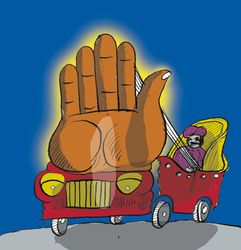As the leaders of the INDIA alliance mull over the invitations they have received to the inauguration of the Ram Temple in Ayodhya, this column makes bold to remind them of a similar occasion in 1951 when the rebuilt Somnath Temple was inaugurated.
The story begins with the integration of Junagadh state with the Indian Union in November 1947. It was immediately announced on the spot that the temple at Somnath, located within the state, which had been destroyed by Mahmud of Ghazni in the early eleventh century, would be rebuilt. The Union cabinet was seized of the issue in December 1947 and the minutes recorded that it had been agreed that the reconstruction of the Somnath Temple would be undertaken at state expense. When Nehru was informed of this, he was furious. Denying that any such decision had been taken, he had the minutes altered accordingly and ordered K.M. Munshi, his minister of works and housing and the most determined proponent of the project, that a secular country could not possibly undertake such an act of historical revenge funded by the treasury. Asked whether, in that case, there would be any objection to finding the means to do so from private sources, Nehru agreed that so long as the state was not involved, there could be no objection to such a private initiative.
Munshi, backed by Sardar Vallabhbhai Patel, then set about raising funds through crowd funding and massive donations from some industrialists. By 1950, enough had been collected to begin the reconstruction of the temple. This too was completed by 1951 and the organisers were all set for a grand inauguration when a further complication arose. They wanted the president, Dr Rajendra Prasad, to be present. Prasad was keen to go. Nehru, totally alarmed at this wanton display of state patronage to a private religious function, convened a cabinet meeting that passed a resolution requesting the president not to go as this would be violative of the fundamental principle of our constitutional democracy that the state has no religion.
When the president insisted on going, the cabinet again advised him, in the interests of preserving a strict line between personal religion and state action, not to go. This stymied the president as the Constitution specified that the president could return for reconsideration any decision of the cabinet but not if it were reiterated.
Prasad then enquired whether he could go in his personal capacity. Nehru’s view was that he was free to do what he wished as a private citizen but not as one holding the highest constitutional position in the land. Which meant that neither protocol nor security could be provided to Prasad at Somnath. At this point, Morarji Desai, home minister in Bombay, came up with an alternative. The Bombay Province Fairs and Melas Act provided that it was the state‘s responsibility to ensure law and order at fairs. As such, this act could be tweaked to provide the president, albeit in his personal capacity, with the protection he needed. The organisers would look after protocol. Thus, the separation of the state from religion was preserved but could not be portrayed as anything but vengeance on history and holding our largest minority responsible for whatever their co-religionists might have done a millennia ago. This to Nehru was anathema.
On emerging from the challenge to his secularism from within, Nehru, on Gandhi Jayanti, 1951, gave the nation his understanding of secular activism: “If anyone raises his hand against another in the name of religion, I will fight him till the last breath of my life, whether from within the government or outside.” Thus, was laid the foundations of secular India.
Aiyar is a former Union minister and social commentator.


